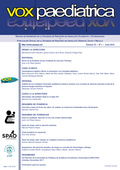![]()
Asma de riesgo vital: manejo en cuidados intensivos pediátricos
El concepto de estatus asmático (SA) hace referencia a una exacerbación asmática aguda severa que no responde adecuadamente al tratamiento convencional optimizado y máximo, y que compromete o puede comprometer la vida. Las principales causas inmediatas de muerte son el síndrome de fuga aérea (neumotórax) y el shock cardiogénico por taponamiento. En la fisiopatología de SA intervienen la alteración de la ventilación-perfusión, aumento del espacio muerto, incremento del trabajo respiratorio y de la resistencia (hiperinsuflación dinámica) y alteración hemodinámica (shock cardiogénico por taponamiento cardiaco).
La escala más utilizada para valorar la gravedad de la crisis asmática es Pulmonary score. Los criterios de ingreso en la Unidad de Cuidados Intensivos son: signos y síntomas de dificultad respiratoria grave tras el tratamiento inicial, Saturación de O2 < 90 % con Fracción inpirada de O2 > 0,4, Presión parcial de CO2 > 45 mmHg y arritmias.
Los puntos clave del tratamiento del SA son la optimización del tratamiento convencional, utilización precoz de la ventilación no invasiva, y como última opción la ventilación mecánica, con el objetivo de reducir la hiperinsuflación dinámica, evitar volo-barotrauma e hipoventilación controlada (hipercapnia permisiva pH > 7,20). Una sedación efectiva durante la ventilación mecánica es crucial ya que disminuye el consumo de oxígeno y la producción de CO2 y asegura la sincronía paciente-ventilador. Cuando la PaCO2 vuelve a niveles normales, se debe suspender la paralización y reducir la sedación, para comenzar el proceso de retirada de la ventilación artificial. Si el paciente permanece consciente, con los signos vitales y el intercambio gaseoso estable durante 60-120 minutos de ventilación, debe ser extubado.
The concept of asthmatic status (AS) refers to a severe acute asthmatic exacerbation that does not respond adequately to optimized and maximized conventional treatment, and that compromises or can compromise life. The main immediate causes of death are air leak syndrome (pneumothorax) and cardiogenic shock from cardiac tamponade. Alteration of ventilation- perfusion, increased dead space, increased respiratory work and resistance (dynamic hyperinflation), and hemodynamic alteration (cardiogenic shock due to cardiac tamponade) are involved in the pathophysiology of SA.
The most commonly used scale to assess the severity of the asthmatic crisis is the Pulmonary score. The criteria for admission to the Intensive Care Unit are: signs and symptoms of severe respiratory distress after initial treatment, SatO2 <90% with FiO2> 40%, pCO2> 45, and arrhythmias.
The key points of the AS treatment are the optimization of conventional treatment, early use of non-invasive ventilation, and as a last option, mechanical ventilation with the aim of reducing dynamic hyperinflation, avoiding volo-barotrauma and controlled hypoventilation (permissive hypercapnia pH> 7.20). Effective sedation during mechanical ventilation is crucial as it decreases oxygen consumption and CO2 production, and ensures patient-ventilator synchrony. When the PaCO2 returns to normal levels, the paralysis should be suspended and the sedation reduced, to begin the weaning of the artificial ventilation. If the patient remains conscious, with stable vital signs and gas exchange for 60-120 minutes, he should be extubated.
| Adjunto | Tamaño |
|---|---|
| vox_paediatr_2018_25_56-60.pdf | 152.58 KB |



